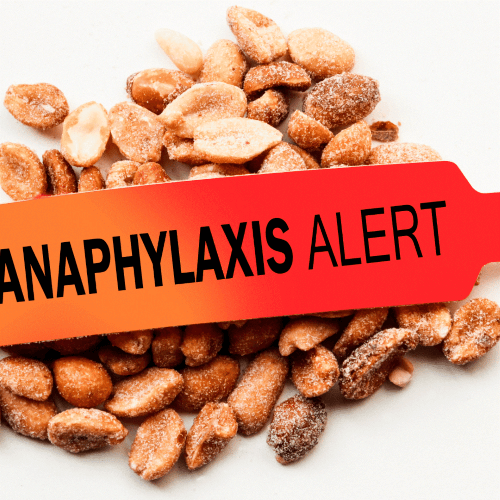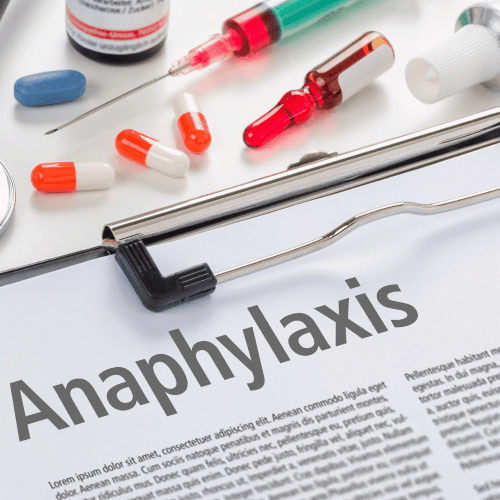Anaphylaxis is a severe allergic reaction. It causes rash, low pulse, and anaphylactic shock. This allergic reaction can be life threatening if not treated right away. When you have anaphylaxis, your immune system releases a rush of chemicals that can put you into shock — your blood pressure drops abruptly and your airways narrow, making it difficult to breathe.
What are the major symptoms of Anaphylaxis attack?
Anaphylaxis symptoms usually appear 5 to 30 minutes after you come into contact with the allergen to which you are allergic. In some circumstances, it may take more than an hour to discover anaphylactic symptoms. The following are examples of warning symptoms that may impact more than one portion of the body:
- Feeling of impending doom
- Wheezing
- Passing out
- Diarrhea
- Trouble breathing, cough
- Hoarse voice
- Chest tightness
- Trouble swallowing
- Vomiting
- Stomach cramping
- Pale or red color to the face and body
Causes
Immune system produces antibodies to protect against foreign chemicals. This is useful when a foreign substance, such as germs or viruses, is hazardous. However, some people’s immune systems overreact to chemicals that aren’t ordinarily allergic to them.
Although most allergy symptoms aren’t life-threatening, a severe allergic reaction can result in anaphylaxis. Even if you or your kid has previously experienced only a moderate anaphylactic reaction, another exposure to the allergy-causing agent increases the chance of more severe anaphylaxis.
Food allergies, such as those to peanuts and tree nuts, fish, shellfish, wheat, soy, sesame, and milk, are the most common anaphylaxis triggers in children. Aside from peanuts, nuts, fish, sesame, and shellfish allergies. In addition to allergies to peanuts, almonds, fish, sesame, and shellfish, adult anaphylactic triggers include:
 Certain drugs, including as antibiotics, aspirin, and other over-the-counter pain treatments, as well as intravenous (IV) contrast used in several imaging studies, are available without a prescription.
Certain drugs, including as antibiotics, aspirin, and other over-the-counter pain treatments, as well as intravenous (IV) contrast used in several imaging studies, are available without a prescription.
Although rare, anaphylaxis can occur as a result of cardiovascular exercise such as jogging or even less severe physical activity such as walking. Anaphylaxis has also been connected to eating particular meals before exercising or exercising in hot, cold, or humid circumstances in some persons. Consult your doctor about any precautions you should take when exercising.
How to Diagnose Anaphylaxis attack?
Certain tests can assist identify the allergen if you don’t know what causes an allergy attack. Anaphylaxis can be caused by a variety of things, and the reason of anaphylaxis isn’t always known (idiopathic anaphylaxis).
Anaphylaxis is first and foremost a medical diagnostic. The patient’s airway, respiration, circulation, and mentation should all be assessed initially during the physical examination (eg, alertness, orientation, coherence of thought).
 Examination may reveal the following findings:
Examination may reveal the following findings:
General appearance and vital signs: Vary according to the degree of the anaphylactic crisis and the organ system(s) affected; patients are usually restless and nervous
Neurologic: Alternate mentation; low level of consciousness; or aggressive and/or belligerent.
Respiratory findings: Severe angioedema of the tongue and lips; tachypnea; stridor or severe air hunger; loss of voice, hoarseness, and/or dysphonia; wheezing
Cardiovascular: Without any other symptoms, tachycardia, hypotension, cardiovascular collapse, and shock can develop.
Dermatologic: Urticaria (hives) anyplace on the body; angioedema (soft-tissue swelling); and generalised (whole-body) erythema (or flushing) without urticaria or angioedema are the most common skin manifestations.
Gastrointestinal: Vomiting, diarrhea, and abdominal distention
How Is it Treated?
Assist someone who is experiencing an attack by assuring them that aid is on the way. Place the individual on their back. Raise their feet 12 inches and wrap a blanket around them.
If the victim has been stung, apply pressure to the skin an inch below the stinger with a plastic card. Slide the card slowly towards the stinger. Flick the card upward once it’s under the stinger to release the stinger from the skin. Tweezers should not be used. More venom is injected by squeezing the stinger.
If the person has access to emergency allergy medicine, give it to them. If the person is experiencing problems breathing, don’t try to give them an oral drug.
If the person has stopped breathing or their heart has stopped beating, CPR will be required.
At the hospital, people with anaphylaxis are given adrenaline, the colloquial name for epinephrine, medication to lessen the reaction. Notify your healthcare professional if you’ve already given yourself or had someone else give you this drug.
Oxygen, cortisone, an antihistamine, or a fast-acting beta-agonist inhaler may also be administered.
How to Prevent anaphylaxis attack?
The best way to prevent Anaphylaxis attack is to avoid allergy causing substances. The following instructions highlights the best preventions.
- Wear a medical alert necklace or bracelet to signal you have an allergy to specific medications or other chemicals.
- Keep an emergency kit with prescribed medications available at all times. Your service provider can help you with the material. Check the expiration date on your epinephrine autoinjector and make sure you replenish the prescription before it runs out.
- Make sure you tell all of your doctors about any pharmaceutical reactions you’ve had.
- If you’re allergic to stinging insects, avoid them if possible. Wear long-sleeved shirts and slacks; don’t walk barefoot on grass; don’t wear bright colors; don’t wear perfumes, colognes or scented lotions; and don’t drink from open soda cans outside. Stay calm when near a stinging insect. Slowly back away from the insect and avoid slapping it.
- If you have food allergies, carefully read the labels of all the goods you buy and eat. Manufacturing techniques can vary, so it’s vital to occasionally examine the labels of items you commonly eat.
- When eating out, inquire about the preparation of each dish and the materials it contains. Even modest amounts of an allergenic food can trigger a severe reaction.
Nursing revalidation provide an interactive training to understand, prevent and provide best care to anaphylaxis. Join the course to get advance learning about anaphylaxis attack and its prevention.

